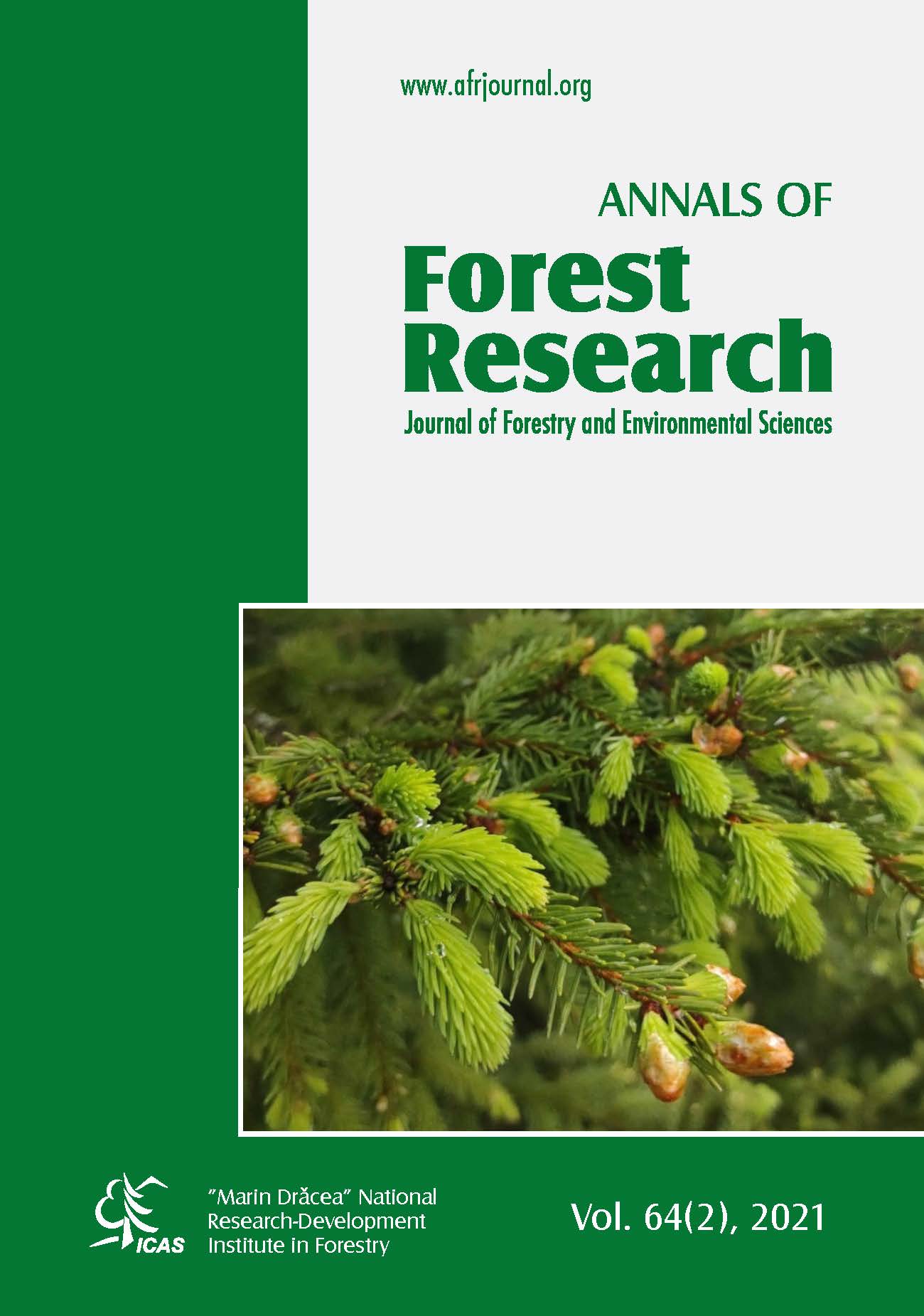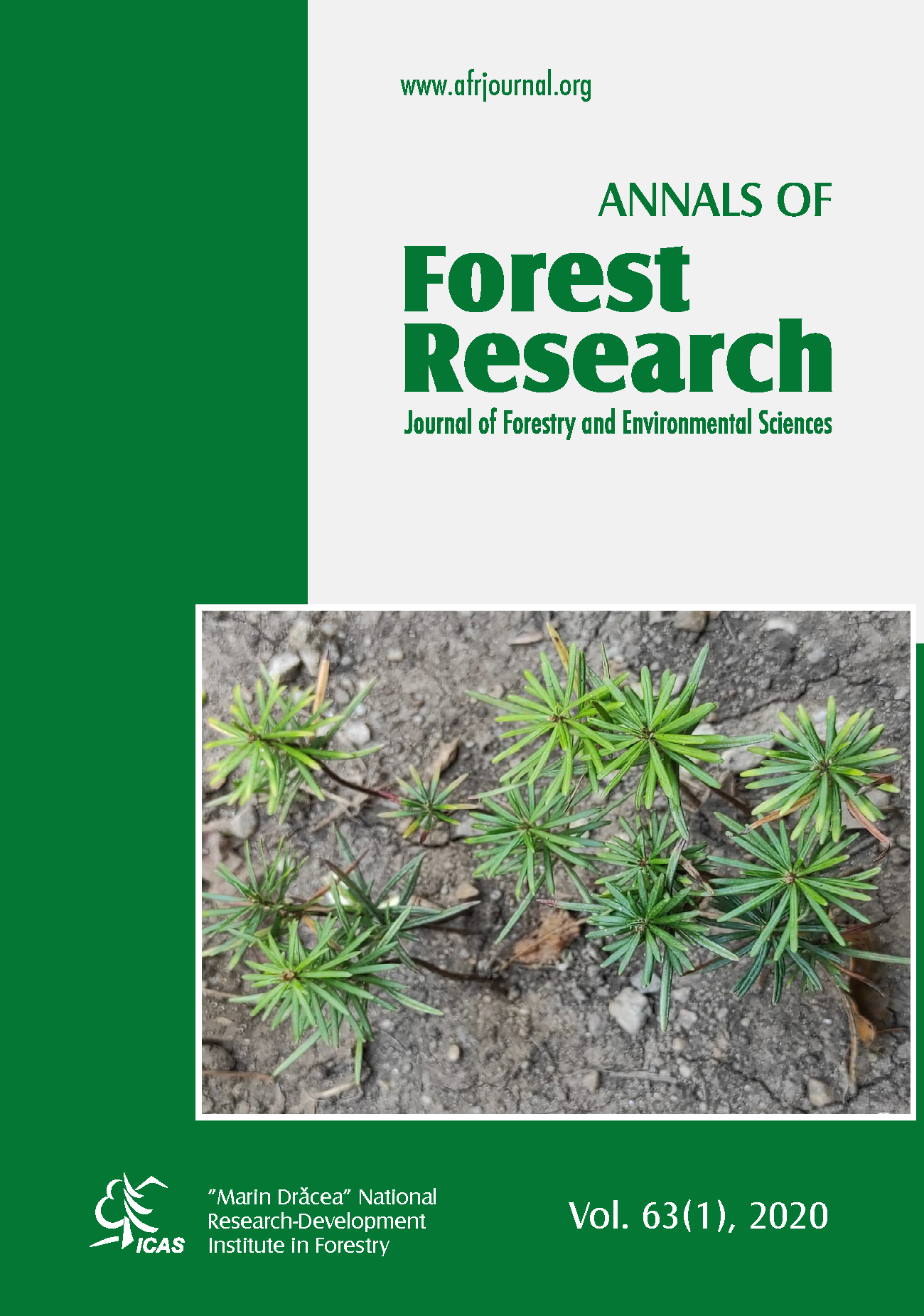Variation in aboveground biomass carbon accumulation in Scots pine seed orchards progeny
DOI:
https://doi.org/10.15287/afr.2021.2062Keywords:
allometry, Pinus sylvestris, populations, progeny, productivity, sequestration, tree breeding,Abstract
Increasing growth and biomass accumulation in forest stands may positively contribute to carbon (C) sequestration and climate change mitigation. Tree improvement programs develop planting material with enhanced growth and biomass accumulation. Scots pine is commonly planted in Europe, and provides a potential for increased C accumulation in forest biomass when using improved seed origins. Our objective was to investigate variation in standing aboveground C accumulation among the progeny of Scots pine seed orchards in climatically variable environments, where we also compared the amount of accumulated C between the tested populations and commercial stands. The aboveground biomass of trees in two series of replicated common garden trials was estimated with eight allometric equations, converted into C, and expressed per unit area. For each trial site we selected reference stands matching the age, stand composition and forest site type, where the same measurements and calculations were done on sample plots. We specifically expected to find the progeny that would express better growth and greater accumulation of C in their biomass when compared to the reference stands.
Significant and large variation was found among the examined seed sources and trial sites. On average, aboveground C accumulation varied among sites from 31.0 to 60.4 Mg ha-1 (age 22) and from 25.5 to 34.0 Mg ha-1 (age 17). Differences between populations at individual sites ranged from 41% to 55% (age 22), and from 29% to 54% (age 17). However, only a few of the investigated progeny had C accumulation significantly greater than the reference stands, and some had a lower C accumulation, depending on the study site.
This study for the first time quantifies the amount of and variation in aboveground C accumulation among the progeny of Scots pine clonal and seedling seed orchards in Poland. It also contributes to the knowledge of the patterns of within-species variation in growth and biomass accumulation. Variation we found is promising for the potential to enhance C sequestration in forest stands through tree improvement. However, the lower C accumulation or non-significant differences between research trials and reference stands, indicate that the level of growth enhancement from phenotypic selection practiced so far in Polish forestry is limited. For increased C sequestration in planted forests, selection would need to be intensified.
References
Armolaitis K., Varnagiryte-Kabašinskiene I., Stupak I., Kukkola M., Mikšys V., Wójcik J., 2013. Carbon and nutrients of Scots pine stands on sandy soils in Lithuania in relation to bioenergy sustainability. Biomass and Bioenergy, 54: 250-259. https://doi.org/10.1016/j.biombioe.2013.03.034
Barzdajn W., Kowalkowski W., Chmura D.J., 2016. Variation in growth and survival among European provenances of Pinus sylvestris in a 30-year-old experiment. Dendrobiology, 75: 67-77. http://dx.doi.org/10.12657/denbio.075.007
Bert D., Danjon F., 2006. Carbon concentration variations in the roots, stem and crown of mature Pinus pinaster (Ait.). Forest Ecology and Management, 222 (1): 279-295. https://doi.org/10.1016/j.foreco.2005.10.030
Biecek P., 2013. Analiza danych z programem R. Modele liniowe z efektami stałymi, losowymi i mieszanymi. Wydawnictwo Naukowe PWN, Warszawa: pp. 320.
Bronisz K., Zasada M., 2016. Uproszczone wzory empiryczne do określania suchej biomasy nadziemnej części drzew i ich komponentów dla sosny zwyczajnej. Sylwan, 160 (4): 277-283.
Butcher T.B., Hopkins E.R., 1993. Realized gains from breeding Pinus pinaster. Forest Ecology and Management, 58 (3-4): 211-231. https://doi.org/10.1016/0378-1127(93)90146-e
Canadell J.G., Raupach M.R., 2008. Managing forests for climate change mitigation. Science, 320 (5882): 1456-1457. https://doi.org/10.1126/science.1155458
Carson S.D., Garcia O., Hayes J.D., 1999. Realized gain and prediction of yield with genetically improved Pinus radiata in New Zealand. Forest Science, 45 (2): 186-200.
Chmura D.J., Giertych M., Rożkowski R., 2003. Early height growth of Scots pine (Pinus sylvestris L.) progenies from Polish clonal seed orchards. Dendrobiology, 49: 15-23.
Chmura D.J., Guzicka M., Rożkowski R., 2021. Accumulation of standing aboveground biomass carbon in Scots pine and Norway spruce stands affected by genetic variation. Forest Ecology and Management, 496: 119476. https://doi.org/10.1016/j.foreco.2021.119476
Chmura D.J., Guzicka M., Rożkowski R., Chałupka W., 2013. Variation in aboveground and belowground biomass in progeny of selected stands of Pinus sylvestris. Scandinavian Journal of Forest Research, 28 (8): 724-734. https://doi.org/10.1080/02827581.2013.844269
Chmura D.J., Guzicka M., Rożkowski R., Chałupka W., 2017. Allometry varies among related families of Norway spruce. Annals of Forest Science, 74 (2): 36. https://doi.org/10.1007/s13595-017-0631-4
Chmura D.J., Rożkowski R., Chałupka W., 2012. Growth and phenology variation in progeny of Scots pine seed orchards and commercial seed stands. European Journal of Forest Research, 131 (4): 1229-1243. https://doi.org/10.1007/s10342-012-0594-9
Cienciala E., Cerny M., Tatarinov F., Apltauer J., Exnerova Z., 2006. Biomass functions applicable to Scots pine. Trees-Structure and Function, 20 (4): 483-495. https://doi.org/10.1007/s00468-006-0064-4
Dixon R.K., Brown S., Houghton R.A., Solomon A.M., Trexler M.C., Wisniewski J., 1994. Carbon pools and flux of global forest ecosystems. Science, 263 (5144): 185-190.
Eriksson G., Ekberg I., Clapham D., 2013. Genetics applied to forestry. Department of Plant Biology and Forest Genetics, Swedish University of Agricultural Sciences Uppsala: pp.206.
GUS, 2017. Forestry 2017, Statistical Information and Elaborations, Central Statistical Office, Warsaw: pp 373.
Haapanen M., Hynynen J., Ruotsalainen S., Siipilehto J., Kilpeläinen M.-L., 2016. Realised and projected gains in growth, quality and simulated yield of genetically improved Scots pine in southern Finland. European Journal of Forest Research, 135 (6): 997-1009. https://doi.org/10.1007/s10342-016-0989-0
Herrero de Aza C., Turrión M.B., Pando V., Bravo F., 2011. Carbon in heartwood, sapwood and bark along the stem profile in three Mediterranean Pinus species. Annals of Forest Science, 68 (6): 1067. https://doi.org/10.1007/s13595-011-0122-y
Jagodziński A.M., 2011. Raport końcowy z realizacji tematu badawczego "Bilans węgla w biomasie głównych drzew lasotwórczych Polski". Część III B. Wyniki - retencja węgla w biomasie drzew i drzewostanów Kórnik: pp 296.
Jagodziński A.M., Dyderski M.K., Gęsikiewicz K., Horodecki P., 2019. Effects of stand features on aboveground biomass and biomass conversion and expansion factors based on a Pinus sylvestris L. chronosequence in Western Poland. European Journal of Forest Research, 138 (4): 673-683. https://doi.org/10.1007/s10342-019-01197-z
Jagodziński A.M., Dyderski M.K., Gęsikiewicz K., Horodecki P., Cysewska A., Wierczyńska S., Maciejczyk K., 2018. How do tree stand parameters affect young Scots pine biomass? - Allometric equations and biomass conversion and expansion factors. Forest Ecology and Management, 409: 74-83. https://doi.org/10.1016/j.foreco.2017.11.001
Jagodziński A.M., Kałucka I., Horodecki P., Oleksyn J., 2014. Aboveground biomass allocation and accumulation in a chronosequence of young Pinus sylvestris stands growing on a lignite mine spoil heap. Dendrobiology, 72: 139-150. https://doi.org/10.12657/denbio.072.012
Janssens I.A., Sampson D.A., Cermak J., Meiresonne L., Riguzzi F., Overloop S., Ceulemans R., 1999. Above- and belowground phytomass and carbon storage in a Belgian Scots pine stand. Annals of Forest Science, 56 (2): 81-90. https://doi.org/10.1051/forest:19990201
Ķeniņa L., Elferts D., Baders E., Jansons A., 2018. Carbon pools in a hemiboreal over-mature Norway spruce stands. Forests, 9 (7). https://doi.org/10.3390/f9070435
Kenina L., Jaunslaviete I., Liepa L., Zute D., Jansons A., 2019. Carbon pools in old-growth Scots pine stands in hemiboreal Latvia. Forests, 10 (10). https://doi.org/10.3390/f10100911
Kowalczyk J., Wojda T., 2019. Result of the 35 years provenance experiment with Scots pine from the IUFRO 1982 series on the trials in Wyszkow and Sekocin. Sylwan, 163 (7): 584-589. https://doi.org/10.26202/sylwan.2018153
Kuznetsova A., Brockhoff P.B., Christensen R.H.B., 2017. lmerTest Package: Tests in Linear Mixed Effects Models. 2017, 82 (13): 26. https://doi.org/10.18637/jss.v082.i13
Laiho R., Laine J., 1997. Tree stand biomass and carbon content in an age sequence of drained pine mires in southern Finland. Forest Ecology and Management, 93 (1): 161-169. https://doi.org/10.1016/S0378-1127(96)03916-3
Lenth R., 2019. emmeans: Estimated Marginal Means, aka Least-Squares Means. R package version 1.3.4. https://CRAN.R-project.org/package=emmeans.
Malhi Y., Meir P., Brown S., 2002. Forests, carbon and global climate. Philosophical Transactions of the Royal Society of London Series A - Mathematical Physical and Engineering Sciences, 360 (1797): 1567-1591.
Matisons R., Adamovics A., Jansone D., Bigaca Z., Jansons A., 2018. Climatic Sensitivity of the Top-Performing Provenances of Scots Pine in Latvia. Baltic Forestry, 24 (2): 228-233.
Matisons R., Krisans O., Karklina A., Adamovics A., Jansons A., Gartner H., 2019. Plasticity and climatic sensitivity of wood anatomy contribute to performance of eastern Baltic provenances of Scots pine. Forest Ecology and Management, 452. https://doi.org/10.1016/j.foreco.2019.117568
Matziris D.I., 2000. Genetic variation and realized genetic gain from Aleppo pine tree improvement. Silvae Genetica, 49 (1): 5-10.
Matziris D., 2005. Genetic variation and realized genetic gain from black pine tree improvement. Silvae Genetica, 54 (3): 96-104.
Mehtatalo L., 2019. lmfor: Functions for Forest Biometrics. R package version 1.3. https://CRAN.R-project.org/package=lmfor.
Muukkonen P., 2007. Generalized allometric volume and biomass equations for some tree species in Europe. European Journal of Forest Research, 126 (2): 157-166. https://doi.org/10.1007/s10342-007-0168-4
Oleksyn J., Reich P.B., Chalupka W., Tjoelker M.G., 1999. Differential above- and below-ground biomass accumulation of European Pinus sylvestris populations in a 12-year-old provenance experiment. Scandinavian Journal of Forest Research, 14 (1): 7-17.
Payn T., Carnus J.-M., Freer-Smith P., Kimberley M., Kollert W., Liu S., Orazio C., Rodriguez L., Silva L.N., Wingfield M.J., 2015. Changes in planted forests and future global implications. Forest Ecology and Management, 352: 57-67. https://doi.org/10.1016/j.foreco.2015.06.021
R Core Team, 2019. R: A language and environment for statistical computing. R Foundation for Statistical Computing, Vienna, Austria. URL https://www.R-project.org/
Rożkowski R., Chałupka W., Misiorny A., Giertych M., 2007. Early evaluation of open pollinated offspring from Polish seedling seed orchards of Pinus sylvestris L. Dendrobiology, 57: 35-48
Sedjo R., Sohngen B., 2012. Carbon sequestration in forests and soils. Annual Review of Resource Economics, 4 (1): 127-144. https://doi.org/10.1146/annurev-resource-083110-115941
Thomas S.C., Martin A.R., 2012. Carbon Content of Tree Tissues: A Synthesis. Forests, 3 (2): 332
Tolunay D., 2009. Carbon concentrations of tree components, forest floor and understorey in young Pinus sylvestris stands in north-western Turkey. Scandinavian Journal of Forest Research, 24 (5): 394-402. https://doi.org/10.1080/02827580903164471
Weng Y.H., 2011. Early realized gains for two-cycle selection for black spruce and their implications for testing effort allocation. Silvae Genetica, 60 (5): 178-186
Weng Y.H., Tosh K., Adam G., Fullarton M.S., Norfolk C., Park Y.S., 2008. Realized genetic gains observed in a first generation seedling seed orchard for jack pine in New Brunswick, Canada. New Forests, 36 (3): 285-298. https://doi.org/10.1007/s11056-008-9100-0
Węgiel A., Polowy K., 2020. Aboveground carbon content and storage in mature Scots pine stands of different densities. Forests, 11 (2). https://doi.org/10.3390/f11020240
Wutzler T., Profft I., Mund M., 2011. Quantifying tree biomass carbon stocks, their changes and uncertainties using routine stand taxation inventory data. Silva Fennica, 45 (3): 359-377. doi: 44910.14214/sf.449
Zasada M., Bronisz K., Bijak S., Wojtan R., Tomusiak R., Dudek A., Michalak K., Wróblewski L., 2008. Wzory empiryczne do określania suchej biomasy nadziemnej części drzew i ich komponentów. Sylwan, 152 (3): 27-39
Downloads
Published
Issue
Section
License
All the papers published in Annals of Forest Research are available under an open access policy (Gratis Gold Open Access Licence), which guaranty the free (of taxes) and unlimited access, for anyone, to entire content of the all published articles. The users are free to "read, copy, distribute, print, search or refers to the full text of these articles", as long they mention the source.
The other materials (texts, images, graphical elements presented on the Website) are protected by copyright.
The journal exerts a permanent quality check, based on an established protocol for publishing the manuscripts. The potential article to be published are evaluated (peer-review) by members of the Editorial Board or other collaborators with competences on the paper topics. The publishing of manuscript is free of charge, all the costs being supported by Forest Research and Management Institute.
More details about Open Access:
Wikipedia: http://en.wikipedia.org/wiki/Open_access






